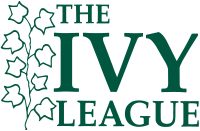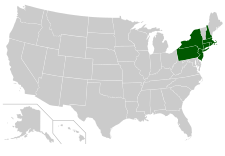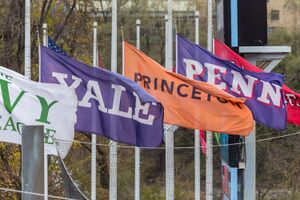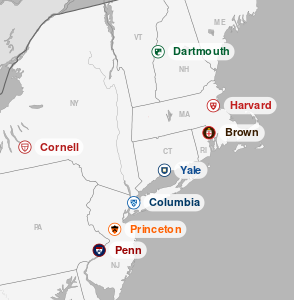رابطة اللبلاب
| Ivy League | |
|---|---|
 | |
| التأسيس | 1954 |
| الرابطة | NCAA |
| القسم | Division I |
| القسم الفرعي | FCS |
| الأعضاء | 8 |
| الرياضات |
|
| المنطقة | Northeast |
| المقر الرئيسي | Princeton, New Jersey |
| المفوض | Robin Harris[1] (منذ 2009) |
| الموقع الإلكتروني | ivyleague |
| المواقع | |
 | |

رابطة اللبلاب (بالإنجليزية: Ivy League وتنطق: آيڤي ليگ)هي رابطة رياضية تجمع ثمان جامعات يعتبروا أرقى جامعات أمريكا ويدخلهم أبناء النخبة (بجانب الأخرين من المؤهلين). ولقدمهم فكلهم يقعوا في الشمال الشرقي للولايات المتحدة. لكن يتم احياناً الخلط بالجامعات المتميزة في الهندسة، والتي يتصدرها معهد تكنولوجيا ماساتشوستس و جامعة ستانفورد وغيرهم وبين رابطة اللبلاب.
أعضاء رابطة اللبلاب
- هارڤارد: كمبريدج (ماساتشوستس) تأسست عام 1636.
- يل: نيو هيفن (كنتيكت)، تأسست عام 1701.
- پرنستون: پرنستون (نيو جيرزي)، تأسست عام 1746.
- كلومبيا: مدينة نيويورك، تأسست عام 1754.
- پنسلفانيا: فيلادلفيا (پنسلفانيا)، تأسست عام 1749.
- كورنل: إيثاكا (نيويورك)، تأسست عام 1865.
- براون: پروڤيدانس، رود أيلاند)، تأسست عام 1764.
- دارتموث: هانوڤر، نيو هامپشر)، تأسست عام 1769.
وتقبل تلك الجامعات الطلبة من كافة أنحاء العالم بناء على مؤهلاتهم الدراسية والشحصية والرياضية. وكما أن هناك رابطة اللبلاب بالجامعات فإن هناك رابطة تأهيل اللبلاب Ivy Prep League لمدارس النخبة (ابتدائي حتى ثانوي) والتي تفخر بمستوى التعليم الذي تمنحه لطلابها مما يؤهلهم لدخول جامعات رابطة اللبلاب بنسب عالية.
| الجامعة | الموقع | اسم التدليل الرياضي | عدد طلاب قبل البكالوريوس | الشعار |
|---|---|---|---|---|
| جامعة براون | پروڤيدنس، رود أيلاند | Bears | 5,821[2] | In deo speramus ("أملنا في الله") |
| جامعة كلومبيا | نيويورك، نيويورك | الأسود | 7,407[3] | In lumine Tuo videbimus lumen ("بنورك سنرى الضوء") |
| جامعة كورنل | إيثاكا، نيويورك | Big Red | 13,510[4] | "سأسس معهداً يستطيع فيه أي شخص أن يجد التعليم في أي دراسة." |
| كلية دارتموث | هانوڤر، نيو همپشر | Big Green | 4,085[5] | Vox clamantis in deserto ("صوت يصرخ في البرية،" "صوت الصارخ في البرية")[6] |
| جامعة هارڤرد | كمبريدج، مساتشوستس | Crimson | 6,715[7] | Veritas ("الحقيقة") |
| جامعة پرنستون | پرنستون، نيوجرزي | Tigers | 4,678[8] | Dei sub numine viget ("تزدهر بقدرة الله") |
| جامعة پنسلڤانيا | فيلادلفيا، پنسلڤانيا | Quakers | 10,163[9] | Leges sine moribus vanae ("القوانين بدون أخلاق لا قيمة لها")[10] |
| جامعة يل | نيو هاڤن، كنتيكت | Bulldogs | 5,275[11] | אורים ותומים Lux et veritas ("النور والحقيقة") |
التاريخ
تأسيس الجامعات
| الجامعة | تأسست | العلاقة الدينية المؤسـِسة |
|---|---|---|
| جامعة هارڤارد[12] | 1636, but named كلية هارڤارد in 1639 | Congregationalist; sided with the Unitarians in their 1825 split from Congregationalists |
| جامعة ييل | 1701 as Collegiate School | Congregationalist |
| جامعة پنسلڤانيا | 1740[13] | Nonsectarian,[14] but founded by Church of England members[15][16] |
| جامعة پرنستون | 1746 as College of New Jersey | Nonsectarian, but founded by Presbyterians[17] |
| جامعة كلومبيا | 1754 تأسست باسم King's College | كنيسة إنگلترة |
| جامعة براون | 1764 as College of Rhode Island | Baptist[18] |
| كلية دارتموث | 1769 | Congregationalist |
| جامعة كورنل | 1865 | Nonsectarian |
- Note Founding dates and religious affiliations are those stated by the institution itself. Many of them had complex histories in their early years and the stories of their origins are subject to interpretation. See footnotes for details where appropriate. "Religious affiliation" refers to financial sponsorship, formal association with, and promotion by, a religious denomination. All of the schools in the Ivy League are private and not currently associated with any religion.
أصل التسمية
The first usage of "Ivy" in reference to a group of colleges is from sportswriter Stanley Woodward (1895-1965).
A proportion of our eastern ivy colleges are meeting little fellows another Saturday before plunging into the strife and the turmoil.
المصادر
- ^ "Executive Director Robin Harris". Archived from the original on أبريل 5, 2016. Retrieved أبريل 1, 2016.
- ^ Facts about Brown University
- ^ Planning and Institutional Research | FACTS
- ^ Cornell Factbook - Undergraduate Enrollment
- ^ http://www.dartmouth.edu/~oir/pdfs/enrollments.pdf
- ^ The former English translation is that more commonly used by Dartmouth itself
- ^ Harvard University Office of News and Public Affairs | Harvard at a Glance
- ^ Princeton - A Princeton Profile - chapter title
- ^ Penn: Facts and Figures
- ^ The English translation is that used by Penn itself
- ^ Factsheet - Statistical Summary of Yale University
- ^ The institution, though founded in 1636, did not receive its name until 1639. It was nameless for its first two years
- ^ See University of Pennsylvania for details the circumstances of Penn's origin. Penn's self-stated founding date of 1740 is a matter of longstanding controversy between Penn and Princeton boosters.
- ^ Penn's website, like other sources, makes an important point of Penn's heritage being nonsectarian, associated with Benjamin Franklin and the Academy of Philadelphia's nonsectarian board of trustees: "The goal of Franklin's nonsectarian, practical plan would be the education of a business and governing class rather than of clergymen."[1]. Jencks and Riesman (2001) write "The Anglicans who founded the University of Pennsylvania, however, were evidently anxious not to alienate Philadelphia's Quakers, and they made their new college officially nonsectarian." Franklin himself was a self-described "thorough Deist." In Franklin's 1749 founding Proposals relating to the education of youth in Pensilvania(page images), religion is not mentioned directly as a subject of study, but he states in a footnote that the study of "History will also afford frequent Opportunities of showing the Necessity of a Publick Religion, from its Usefulness to the Publick; the Advantage of a Religious Character among private Persons; the Mischiefs of Superstition, &c. and the Excellency of the CHRISTIAN RELIGION above all others antient or modern." Starting in 1751, the same trustees also operated a Charity School for Boys, whose curriculum combined "general principles of Christianity" with practical instruction leading toward careers in business and the "mechanical arts." [2], and thus might be described as "non-denominational Christian." The charity school was originally planned, and chartered on paper, in 1740, by followers of evangelist George Whitefield, but was not built and did not operate until the charter was assumed by the Academy of Philadelphia in 1751. Since 1895, Penn has claimed a founding date of 1740, based on the charity school's charter date and the premise that it had institutional identity with the Academy of Philadelphia. Whitefield was a firebrand Methodist associated with The Great Awakening; since the Methodists did not formally break from the Church of England until 1784, Whitefield in 1740 would be labelled Episcopalian, and in fact Brown University, emphasizing its own pioneering nonsectarianism, refers to Penn's origin as "Episcopalian"[3]). Penn is sometimes assumed to have Quaker ties (its athletic teams are called "Quakers," and the cross-registration alliance between Penn, Haverford, Swarthmore and Bryn Mawr is known as the "Quaker Consortium.") But Penn's website does not assert any formal affiliation with Quakerism, historic or otherwise, and Haverford College implicitly asserts a non-Quaker origin for Penn when it states that "Founded in 1833, Haverford is the oldest institution of higher learning with Quaker roots in North America."[4]
- ^ Protestant Episcopal Church - LoveToKnow 1911
- ^ Brown Admission: Our History
- ^ University Chapel: Orange Key Virtual Tour of Princeton University
- ^ Brown's website characterizes it as "the Baptist answer to Congregationalist Yale and Harvard; Presbyterian Princeton; and Episcopalian Penn and Columbia," but adds that at the time it was "the only one that welcomed students of all religious persuasions."[5] Brown's charter stated that "into this liberal and catholic institution shall never be admitted any religious tests, but on the contrary, all the members hereof shall forever enjoy full, free, absolute, and uninterrupted liberty of conscience." The charter called for twenty-two of the thirty-six trustees to be Baptists, but required that the remainder be comprised of "five Friends, four Congregationalists, and five Episcopalians"[6]
- ^ "Yale Book of Quotations" (2006) Yale University Press edited by Fred R. Shapiro
وصلات خارجية
